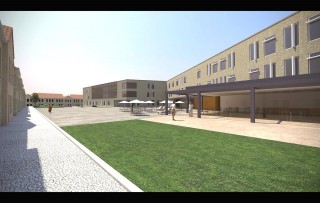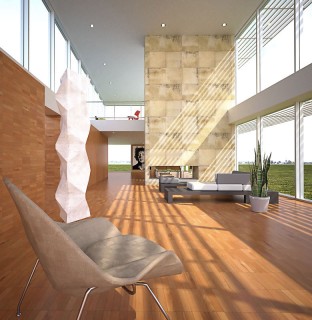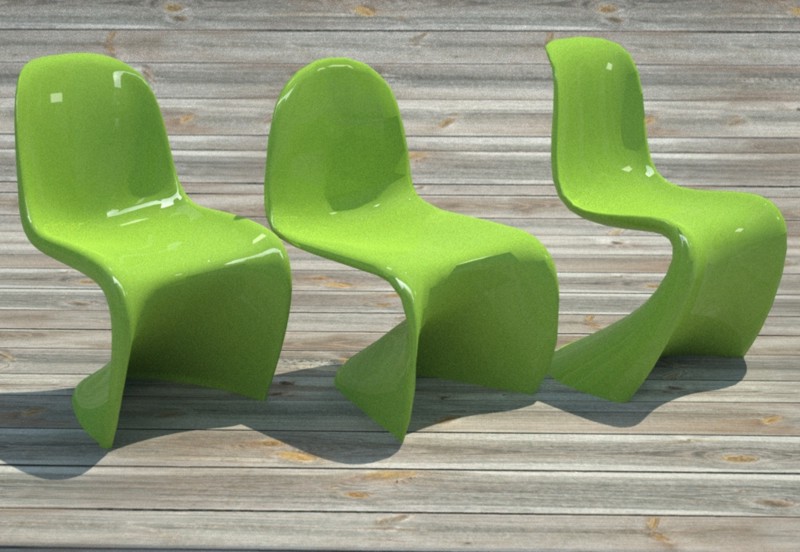Giving Maxwell another shot
-
Hi Jeff and all,
probably far too early for me to take part in a Maxwell thread as I have only just downloaded version 1.5, the demo, and not really worked with Maxwell at all before. Trying to evaluate if I am going to purchase a license.
Firstly, although I understand what you are saying about bevelled edges etc. I really like your render, the interior scene. It has a very nice soft feel to it, great. It is exactly what I would like to be able to do...
I have fiddled with Maxwell a little now, exported the geometry from SU, opened in Studio and played with the interface and scanned through the manual. I am totally overwhelmed with the possibilities one has, setting and fine tuning, it is quite amazing, really.
I have limited render experience, done some acceptable work with ArtlantisR (just gone off it a bit recently). I was wondering if you guys who are so good with Maxwell would share a few tips and tricks regarding the workflow from SU, first steps in Studio, what are good settings for certain things, what to avoid, that sort of thing. I know, most of the time all this is hugely dependent on the actual scene and what type of render, mood, atmoshere is required, nevertheless, there might be a few little general helping comments. What is the first thing you do when opening the file in Studio, what preview settings do you use, what display mode do you set your viewport do...
Maybe we could collect some tips and tricks in this thread and eventually make a small document out of it? Interested?
Anyway, thanks for listening to me rambling on, I would love to hear about your SU-Maxwell experiences.
Kind regards from London, Andy.
Posted by Andrea Glucker
-
@unknownuser said:
The fundamental basis for using SketchUp is ease of use and low-poly modeling. This is where things fall apart. The low-poly work is pretty obvious in high-end renderers (see table base and top). For the most part you can get around this by making a circle 96 segments instead of 24, but then then working with a decent size model thongs start to bog down. A room full of high-poly chairs and tables gets pretty messy, pretty quickly.
One workaround to the issue of messy, slow, highpoly models is the use of dummy components. In the case of your image, you could create high poly versions of the table and chairs and then use the Sketchup Component browser to replace the low poly versions just prior to exporting to Maxwell. Even better would be if this process could be performed automatically when you export. This feature will be in the next version of SkIndigo (Indigo exporter). It is a truly powerful and useful feature and I expect other render exporters will also have that feature in the future.
http://www.indigorenderer.com/joomla/forum/viewtopic.php?t=1177&postdays=0&postorder=asc&start=30Whaat
-
@unknownuser said:
AndreaGlucker wrote:
I am totally overwhelmed with the possibilities one has, setting and fine tuning, it is quite amazing, really.
...I was wondering if you guys who are so good with Maxwell would share a few tips and tricks regarding the workflow from SU, first steps in Studio, what are good settings for certain things, what to avoid, that sort of thing.Hi Andy,
Explaining the whole workflow SU to Maxwell is a tedious job to do.
The manual covers a lot of items, although I find the Maxwell forum to be even a better resource for particular problems.Instead of explaining it all, I'd like to share some basic rules I use myself when using SU in combo with Maxwell.
- TEXTURING:
rule of thumb: What doesn't look good in sketchup, doesn't look good in Maxwell.
Meaning that texturing is one of the most important things (but you probably know that already Wink).
Try to map the most you can in Sketchup (you could do that also in the Maxwell studio but there are fewer options to uv map (=position exactly) textures than in SU.
Don't Change the colors of a bitmap texture in Maxwell.The reason? Maxwell will use the original texture bitmaps and not the edited ones.Do the colour editing in Photoshop instead and replace the texture in SU with the new improved one.
Mind reversed faces (check them in 'monochrome' view= reverse the 'blue' faces).
Explode (if you can) all before exporting. Having a lot of nested groups containing positioned textures sometimes gives distorted textures in Maxwell.(exploding not always does the trick. Another workaround would be copying the textured objects and rotating them out of your view. Don't ask me why this helps, it's a strange thing, but it does as you will learn;)
TEXTURING IN MAXWELL STUDIO: Download .mxm materials from the .mxm website. Some are really good. They can be used as a starting point for making your own .mxms. Those mxm materials contain textures. It is good practice already using the bitmaps of the 'diffuse slot' in Sketchup as the texture of your SU material. this saves some time in Studio and the UV-mapping will be as it is on your SU screen.
2.LIGHTING:
OUTDOOR: use the physical sky as it gives radiant output. Try experimenting later on with combining it with an HDRI image as background. (HDRI backgrounds are high dynamic range images that can be used to light your scene).
INDOOR: When using artificial light= assigning an emittive material to an object, see to it that the geometry of that object is as easy as possible (read: low polycount). A simple square is sufficient for most purposes. Don't assign emittive material to rounded objects. render times will sky rocket doing that!.
Be aware that the intensity to give a 'light' is relative to the size of the emitting obect/surface.
Don't be fooled to think that a 60Watt intensity will be the same intensity in real life. sometimes you need to cranck intensity up to the thousands (even the milions Laughing ).- CAMERA SETTINGS:
Use the maxwell camera as if you were using an old analogue real camera. This is important.(shutter speed, fstop,iso, etc...) If you aren't familiar with that, look on the internet for a quick photography lesson. A wrong use of the camera will give a lot of frustration... just as in real live your photographic stills would be screwed up.
4.GENERAL SKETCHUP WORKFLOW:
A good tip: layer as much as you can.
It is good practice to put vegetation, people, ground works, etc. on seperate layers.
This has two purposes:- You will be able to use Sketchup on a 'reasonable' speed by switching off layers that contain a lot of polygons (trees,...). When working on big SU files, layering is a must. If you have a really big file you might want to export to Maxwell in parts.
- If your file is layered it becomes more easy afterwards to re-export certain parts of your model.
In Maxwell studio different parts are easily 'merged' (using the 'import object' function )
I hope these general hints are helpful to you.
Search the Maxwell forum as it is a very good resource.Good luck,
Regards,
KwistenbiebelHere's an image I did using the SU-Maxwell combo:

- TEXTURING:
-
@unknownuser said:
Whaat wrote:
[One workaround to the issue of messy, slow, highpoly models is the use of dummy components. In the case of your image, you could create high poly versions of the table and chairs and then use the Sketchup Component browser to replace the low poly versions just prior to exporting to Maxwell. Even better would be if this process could be performed automatically when you export. This feature will be in the next version of SkIndigo (Indigo exporter). It is a truly powerful and useful feature and I expect other render exporters will also have that feature in the future.
http://www.indigorenderer.com/joomla/forum/viewtopic.php?t=1177&postdays=0&postorder=asc&start=30Whaat
Great feature. Still, that's 2 models for every component. What a pain. Better to learn a different modeler than create and manage all those components. It's doubtful that a group like FormFonts will carry a high and low-poly version of all it's models.
Great tips Kwisty. Thanks.
I will also add, from my fine arts side, that even with complete command of the technical side of archViz, you still be to have a good understanding of color, composition, proportions etc. Study some of the great architectural photographers of our time. Look at the past past images of groups like Hedrick-Blessing.
http://www.hedrichblessing.com/ (take a look at the classic images)
Go to a museum and look at the masterpieces. They all have one thing in common-good control over these basic design criteria. Inspiration comes from the most unlikely places.
-
Jeff Jacobs wrote:
Go to a museum and look at the masterpieces. They all have one thing in common-good control over these basic design criteria. Inspiration comes from the most unlikely places.This is a very valuable tip. I recently started doing this.
May I add a winderful lesson to this?
Look at this link: This 'Chiarroscura' method helped me a lot in boosting the light setup and enhancing composition:
http://www.efplighting.com/?The_Chiaroscuro_PrincipleCheers,
kwistenbiebel -
Hello Guys
Thank you for your input, these are some very valuable tips, Kwisty.
I do not quite understand this one:"[i]Another workaround would be copying the textured objects and rotating them out of your view." Do that in SU? Sorry, lost me...
I have a question with regards to emitters, you are saying keep them simple like a square surface or object that you place in the scene. Say you have an interior scene that is lit by lightbulbs dangling from the ceiling, just as an example. Now, in reality these bulps would "glow", emit light. The bulbs are curvy, "complicated" objects. If you do not want to use them as emitters in your model, would you place simplified objects in the space instead, that can emit but are not visible in the final render and give the visible bulbs a "fake" glow? Is it actually possible to create different types of directional light with Maxwells "emitting approach", meaning floodlights, pointlights, spots, cones, etc. It is not, is it?
Anyway, maybe I should move my questions to the Maxwell forum, your input is very very helpful. Thanks for helping!!!
Regards from a rainy (turning into a thunderstorm right now) London, Andy.
Posted by Andrea Glucker
-
@unknownuser said:
Quote:
[One workaround to the issue of messy, slow, highpoly models is the use of dummy components. In the case of your image, you could create high poly versions of the table and chairs and then use the Sketchup Component browser to replace the low poly versions just prior to exporting to Maxwell. Even better would be if this process could be performed automatically when you export. This feature will be in the next version of SkIndigo (Indigo exporter). It is a truly powerful and useful feature and I expect other render exporters will also have that feature in the future.
WhaatIt's like vray-proxy objects?
When we waiting!!!
Posted by spire7k
-
Another shot at the model I rendered in Modo, but this time in Maxwell. Might be a nice comparison for those interested in either of these two renderers.
Modo render: http://www.sketchucation.com/community/forums/suc/viewtopic.php?f=25&t=254&st=0&sk=t&sd=a&start=10
The Maxwell renders are just so much nicer than anything excpet for maybe Vray. It's all about the light and Maxwell has that down to a science. Trying real hard to get the materials thing figured out. I really need to work on my rice paper material. One of these days.

-
Jeff,
I'm messing around with the Maxwell demo just now and am pretty impressed with the results. I love the SU plugin and export (except the materials editor which is horribly buggy), but render times are horrendous. At first I thought they were great, but that was only to a grainy quality- when I try to leave them longer (25 SL passes) to get a grainless result like yours above it takes days on my laptop which is a fairly decent spec.
I seem to remember you work on a supercomputer (8 CPUs?) Very Happy , but how long would the above image take to render for example?
HP dv8000
Centrino Core Duo T2400 1.83GHz
1.5Gb RAM
nVidia GeForce Go7400Jackson
Jackson
HP dv8000, Centrino Duo T2400 1.83GHz, 1.5Gb RAM,
nVidia GeForce Go7400
SU, AutoCAD, Progecad, MicroGDS, Vue, Maxwell, VRay, Photoshop, Dreamweaver -
Jackson,
The last image ran for 4 hours on my 8-core. A bunch of processors is the only thing that makes Maxwell a real option. I'm going to try to network my old G5 and a couple of dual G4's together to and see if I can't get the network render going. Processors, and lot's of them, are Maxwell's only hope.
Also, little grain is good in my opinion. If an image is too clean then it doesn't look any better that one with a lot of grain. Try duplicating the main image into another layer. Do a high-pass filter at about 4 percent on the copy and set it to overlay. This will sharpen up the details nicely. Then switch back to he original layer and use a plugin like Noise Ninja. This will help kill some of the noise but the high-pass will help the image stay sharp. I've also used Noise Ninja on the high-pass layer, but at a real low setting. This will help with the noise too. I always render my images to at least 3000-3200 on the long side, then reduce after all the above.
-
Jeff,
Thanks for the info. Sadly without Deep Blue Rolling Eyes or access to a network I'll have to restrict my Maxwell work to hobby only- the render times are unworkable for me. Although I've complained for ages about Vue's artefacts and quality of radiosity, it's render times means it actually compares pretty well with Maxwell and other unbiased renderers.
Jackson
p.s. was that render time for a 3000px wide original or for the 800px attachment?
Jackson
HP dv8000, Centrino Duo T2400 1.83GHz, 1.5Gb RAM,
nVidia GeForce Go7400
SU, AutoCAD, Progecad, MicroGDS, Vue, Maxwell, VRay, Photoshop, Dreamweaver -
3000
-
@unknownuser said:
Jeff Jacobs wrote:
3000SPARTAAAA!! (x10)
Sorry for the OT, but the whole 300 / Sparta thing with macros still gets me laughing.
Save the Earth, it's the only planet with chocolate.
+++ NB +++ NB +++ NB +++ NB +++ NB +++
MEMBERS: Have you read the announcement?
Report this post
-
Jeff,
Just 4 hours for a 3000 px wide image in Maxwell?!!! How many teraflops does your machine do?

Let me know when you're upgrading- I'll start saving up for your old machine now!Jackson
Jackson
HP dv8000, Centrino Duo T2400 1.83GHz, 1.5Gb RAM,
nVidia GeForce Go7400
SU, AutoCAD, Progecad, MicroGDS, Vue, Maxwell, VRay, Photoshop, DreamweaverReport this post
-
Hi to everyone, just found my way here now. Cool
Great renderings Jeff, like always. That is the Saarinen table from FormFonts you have in the first render right? I had trouble with those faceted edges on that one myself. It is true that with the added realism of Maxwell those sharp and faceted edges become more apparent than with some other products. The low poly models seem to work better with a more CG:ish look. The problem is often that low-poly geometry that looks fine in SU just doesn’t render well. I have noticed this also when rendering curved surfaces with a shiny surface.
Here is a quick example of three Panton chairs. One is a low-poly FormFonts chair with a messy mesh. One is s rather high poly Evermotion chair with a clean mesh. The third one, found on the SU forum, is something in between. Can you tell which one is the low-poly one?
Image
When I use high-poly models in SketchUp I always try keeping them on separate layers, so you can turn them of when working on different parts of the model. I think SU can handle a big file, but displaying everything in a high-poly model is where the problems start.Nondestructive bevelled edges is definitely on my SU wishlist.
Sheik

-
Sheik
Really glad to see You back. Your Su-Maxwell
expertise was missing here.
-
Middle one is low-poly, left one is high-poly, and right one is the mix.

-
Bingo! ArchitectBoy gets 3/3 points. Notice how the middle one, the low-poly version, has strange uneven shadows and reflections.
-
Greetings from Vancouver. It's BC Day! Woo Hoo!
The one on the right is the only one close to the original shape–low poly, high poly, no poly. Very Happy
-
Who is this "poly" everyone keeps talking about? I've never seen her post her before....

Great work guys! Enjoying the thread.
...still waters, run deep....
Tina Anne Stiles, ASAI
Quality Digital Watercolor Architectural Illustrations
Advertisement







